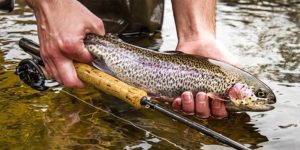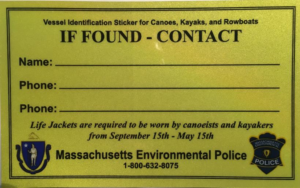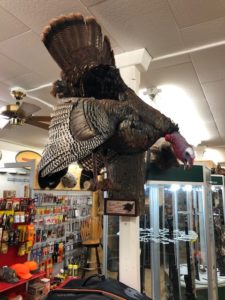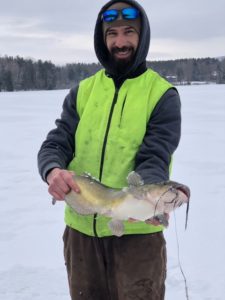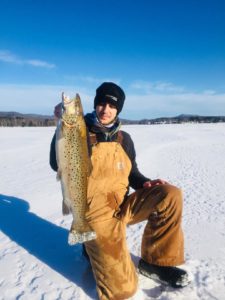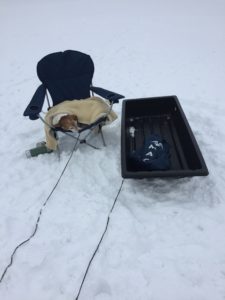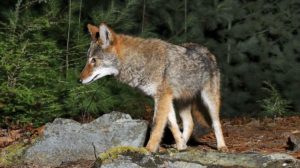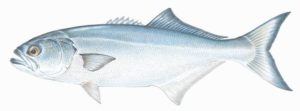This year marks the 40th spring turkey hunting season in Massachusetts. It opens tomorrow morning and runs through May 23. There have been a lot of changes with regard to turkey hunting this past year and this column has relayed them piecemeal during the year. To make sure that all of the turkey hunters are up-to-date with these changes, please bear with me as I list them out again.

MassWildlife cautions us to remember to practice safe social distancing while enjoying the outdoors. COVID-19 related restrictions and precautions will impact some in-person services, including license sales and check stations. Most hunters already take advantage of easy online purchasing and harvest reporting through MassFishHunt. MassWildlife has created some new options to support hunters who are unable to do business online. If you know someone who doesn’t receive their emails, give them a call and let them know what’s happening or have them visit mass.gov/turkey2020 for up-to-date information.
Hunters are strongly encouraged to purchase licenses online. MassWildlife offices are closed until further notice, and many license vendors are closed as well. Hunters can purchase licenses and permits online with a computer or smartphone through MassFishHunt, or through any license vendors that remain open (call first). A printed license and turkey permit must be carried with you while turkey hunting.
There is a new online purchasing option for 15–17 year-olds. Under normal circumstances, minors aged 15–17 must purchase a license in person and provide written parental consent. During the COVID-19 State of Emergency, parents and guardians can use an electronic form to provide consent and then purchase licenses online. You can email mass.wildlife@mass.gov if you have any questions.
Due to COVID-19 public health measures, no check stations will operate during the spring 2020 turkey season, including all MassWildlife locations. Hunters are strongly encouraged to use MassFishHunt to report harvested birds online. Hunters without computer or smartphone access can call MassWildlife to report a harvest over the phone.
To report your harvested turkey over the phone, call your nearest MassWildlife District Office, or the MassWildlife Field Headquarters. Staff will be available to help hunters report their harvest over the phone. When reporting a harvest over the phone, hunters should be prepared to provide the following information: date of harvest, town and Wildlife Management Zone of harvest, the sex and age of the turkey (bearded birds only in spring), and the method of take (shotgun/archery/crossbow). Staff can assist if you are unsure of the sex or age of the turkey.
Note: If you get a busy signal when calling the district office in Dalton ( 413) 684-1646), try again in a few minutes or call the Field Headquarters at (508) 389-6300 to leave a message. If you need to leave a message, include your full name, customer ID number from your hunting license, and a phone number where you can be reached.
Hunters including youth huntersmust follow the standard ½ hour before sunrise to 12 noon hunting hours.
Note: Minors aged 12-14 may hunt with a licensed adult during the regular turkey season. (Minor and licensed adult must share one firearm/bow and share one bag limit.)
All hunting regulations, are still in effect during the State of Emergency and Stay at Home Advisory. Several changes to wild turkey hunting regulations were approved by the Fisheries and Wildlife Board in 2019. The summary below provides an overview of the changes now in effect for the 2020 turkey hunting seasons.
- Increased annual limit of three birds—2 bearded turkeys in the spring and 1 of either sex in the fall.
Prior to the regulation change, turkey hunters were only permitted to harvest either two bearded birds in the spring with no fall birds or one bearded bird in the spring and one bird of either sex in the fall, for an annual limit of two birds. Now, hunters can take 2 bearded birds in the spring and 1 of either sex in the fall. - Increased daily bag limit of two per day during the spring season.
Prior to the regulation change, turkey hunters were only permitted to harvest one turkey per day during the spring season. Now, hunters may fill their spring season limit of 2 bearded turkeys in a single day. - Changed shot size
Prior to the regulation change, turkey hunters were only permitted to use #4–#7 size shot for turkey hunting. With this change, hunters may now take advantage of advanced ammunition that will allow for greater flexibility with different shotguns, including #9 TSS shot produced by several manufacturers. - Expanded Youth Day turkey hunting hours to ½ hour before sunrise until 5 p.m.
Hunting hours were expanded for the Youth Day only (April 25, 2020), providing young hunters with additional turkey hunting opportunity. However; during the regular season,all hunters including youth huntersmust follow the standard ½ hour before sunrise to 12 noon hunting hours.
Surely turkey hunters remember the tragic accidental shooting last year of local turkey hunter Chris Puntin. It would be well to review these safety tips before heading afield:
- While hunting this year, be aware that more hunters and non-hunters may be out and about in the woods and fields as a result of the COVID-19 situation.
- Always follow the 10 basic rules of firearm safety, (listed on mass.gov/service-details/firearms-safety).
- Be completely sure of your target and what is beyond it before you shoot. Always practice firearm safety.
- Do not stalk turkey sounds; it could be another hunter. Sit or stand and call the birds to you.
- Do not wear red, white, blue, or black; these colors are associated with male turkeys.
- Protect your back. Set up against a large tree or rock and make sure your view isn’t obstructed. Don’t hide in a place with an obstructed view.
- Do not place decoys too close to where you set up. Never carry an exposed decoy or tail fan while hunting; put them in a bag when carrying them in or out of hunting locations.
- Consider wearing hunter orange when entering or leaving your hunting area.
- All hunters must have a green safety sticker on their firearm positioned so it can be seen when sighting down the barrel. If you need a new or replacement sticker for your firearm, send a self-addressed stamped envelope to: MassWildlife, Attn: Turkey Safety Sticker, 1 Rabbit Hill Road, Westborough, MA 01581. After you place a safety sticker on your shotgun, put a piece of clear packing tape on top of it and it will last years, even through harsh hunting and weather conditions.
Access to some hunting areas may be impacted by the COVID-19 emergency; hunters should check with landowners about any special restrictions. Again, hunters should be aware that more people may be enjoying the outdoors as a result of COVID-19. Avoid crowded areas and have a back-up plan if your usual hunting spot is crowded.
All MassWildlife Wildlife Management Areas (WMAs) remain open to the public for hunting, fishing, and other outdoor recreation during this time.
Hunters should remain at least 6 feet away from others, avoid gathering in groups, and stay home if they’re feeling sick. Given the current public health situation, MassWildlife recommends that mentors only hunt with immediate family members (within their residence) this year. Massachusetts hunters are reminded that most other states have quarantine orders in place for non-residents crossing state lines. Follow the latest official state guidance and recommendations regarding COVID-19.
MassWildlife will post any new information about the Spring Turkey Hunting Season to Mass.gov/turkey2020. You can easily add or update your email address by logging into your account at any time. Help spread the word to other hunters, especially those who may not have access to email or a computer.
Watch out for ticks! This year appears to be another bad year. Spray your clothes with Permethrin or other suitable insect repellent.
Good luck! Here’s wishing you all a safe and enjoyable turkey hunting season.






